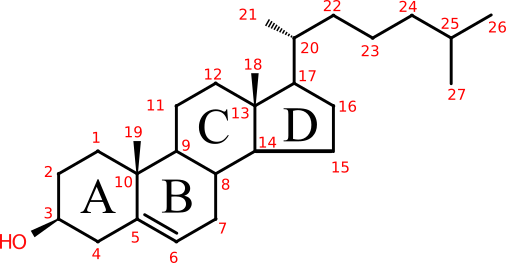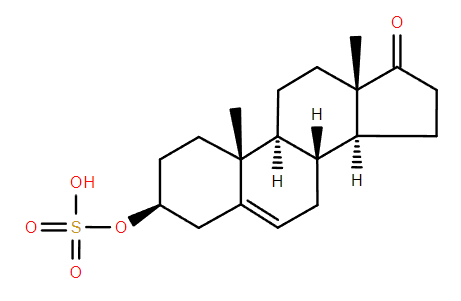Sterols (ST)
The term sterol embraces all molecules based on the cyclopentanoperhydrophenanthrene skeleton. Here the ring system does not add to the number of DBE. The stereochemistry of the cholesterol molecule is maintained to a large extent by mammalian sterols, which all contain at least one hydroxyl or oxo group attached to carbon 3. Within this category bile acids are prominent classes as well.
Carbon numbers of the cyclopentanoperhydrophenanthrene skeleton (example of cholesterol)

Class abbreviations
| Common Name | Lipid Class [LIPID MAPS] | Abbreviation |
|---|---|---|
| Free cholesterol = cholesterol | FC | |
| Sterols | Sterols [ST01] | ST |
| Cholesteryl ester | Cholesteryl esters [ST0102] | CE |
| Steryl esters | Steryl esters [ST0102] | SE |
| Bile acids | Bile acids and derivatives [ST04] | BA |
| Sterylglycosides | Sterylglycosides | SG |
| Acylsterylglycosides | Monoradylglycosterols | ASG |
Specific rules for sterol lipids
- In shorthand notation ST is also used as class abbreviation. In all cases, class abbreviation is followed by number of C-atoms:number of DB, and separated by semicolon is the number of oxygens, e.g. ST 27:1;O for cholesterol and lathosterol (also zymostenol), or ST 24:1;O5 for an oxidized sterol and for cholic acid and ursocholic acid. The latter is an important point: Some bile acids have an identical mass and molecular formula to oxidized sterols lacking a carboxylic acid group. This must be considered, when class abbreviation “BA” is used.
- Shorthand notation of further functional groups are written, separated by a semicolon, after the number of oxygens, e.g. BA 24:1;O4;Tau for taurocholic acid (= common name, abbreviation TCA).
- Following the number of double bonds, proven position and stereochemistry is shown in parentheses. R and S configurations are preferred for side-chain stereochemistry and are shown in square brackets. Alpha, written as a, and beta, written as b, are preferred for ring stereochemistry. Stereochemistry at C-5 introduced by reduction of the Δ5 bond is indicated by 5aH or 5bH. Replacing the number of oxygens, proven positions and stereochemistry of oxygen containing functional groups are shown. If such stereochemistry is known the common name of the compound can be used.
- For structures fully proven or based on assumption by biological intelligence, such as e.g. cholesterol, cholesteryl esters, steryl esters, bile acids, sterolglycosides, and acylsterolglycosides abbreviations FC, CE, SE, BA, SG and ASG. CE is followed by number of C-atoms:number of DBE of the fatty acid esterified to the hydroxyl group at position 3, e.g. CE 18:2. SE is used as above followed by slash (for monohydroxysterols) or undersore (for polyhydroxysterols) number of C-atoms:number DBE of the fatty acid esterified to the hydroxyl group .
- MS/MS scans reveal the presence of conjugates,e.g. taurine (Tau) or glycine (Gly), conjugated through an amide bond to the carboxylic acid group of bile acids; sulfuric acid (S) is conjugated to a hydroxyl group through an ester bond; glucuronic acid (GlcA), N-acetylglucosamine (GlcNAc), and hexose (Hex) sugars are assumed to be linked to a hydroxyl group through an acetal linkage.
- In the case full stereochemistry is known the common names can be used.
Hierarchical shorthand notation for examples of sterols
| Lipid class | Species level | Molecular species level | Full structure level | Complete structure level (= Common Name) |
|---|---|---|---|---|
| ST (FC) | ST 27:1;O | ST 27:1;O | ST 27:1(5Z);3bOH = FC | Cholesterol |
| ST | ST 27:1;O | ST 27:1;O | ST 27:1(7);5aH;3bOH | Lathosterol |
| ST | ST 28:3;O | ST 28:3;O | ST 28:3(5Z,7Z,22E);24Me[R];3bOH | Ergosterol |
| ST | ST 27:2;O3 | ST 27:2;O3 | ST 27:1(5Z);3bOH;26COOH[25R] | 3β-Hydroxycholest-5-en-(25R)26-oic acid |
| SE | SE 43:1* | SE 27:1/16:0* | CE 16:0 | Cholesteryl palmitate |
| SE | SE 45:3* | SE 27:1/18:2* | CE 18:2(9Z,12Z) | Cholesteryl linoleate |
| SE | SE 45:3* | SE 27:2/18:1* | SE 27:2(8E,24);5aH;3bO(FA 18:1(9Z)) | Zymosteryl oleate |
| ST | ST 21:3;O2 | ST 21:3;O2 | ST 21:1(4Z);3oxo,20oxo | Progesterone |
| ST | ST 19:2;O2 | ST 19:2;O2 | ST 19:1(4Z);17bOH;3oxo | Testosterone |
| SE | SE 22:2;O* | SE 19:2;O/3:0* | SE 19:1(4Z);17bO(FA 3:0);3oxo | Testosterone propionate |
| ST | ST 19:2;O2 | ST 19:2;O2 | ST 19:1(5Z);3bOH;17oxo | Dehydroepiandrosterone |
| ST | ST 18:3;O2 | ST 18:3;O2 | ST 18:3(1,3,5);3OH,17bOH | 17β-Estradiol |
| ST | ST 19:2;O2;S | ST 19:2;O2;S | ST 19:1(5Z);3bS;17oxo |
Dehydroepiandrosterone sulfate

|
| BA | ST 24:1;O5 | ST 24:1;O5 | BA 24:0;5bH;3aOH,7aOH,12aOH;24COOH | Cholic acid (CA) |
| BA | ST 24:1;O3 | ST 24:1;O3 | BA 24:0;5bH;3aOH;24COOH | Lithocholic acid (LCA) |
| BA | BA 24:1;O4;Tau | BA 24:1;O4;Tau | BA 24:0;5bH;3aOH,7aOH,12aOH;24COT | Taurocholic acid (TCA) |
| BA | BA 24:1;O3;Gly | BA 24:1;O3;Gly | BA 24:0;5bH;3aOH,7aOH;24COG | Glycochenodeoxycholic acid (GCDCA) |
| BA | ST 24:1;O4;HexNAc | ST 24:1;O4;HexNAc | BA 24:0;5bH;3aOH,7bOGlcNAc;24COOH | Ursodeoxycholic acid 7β-N-acetylglucosaminide (UDCA-GlcNac) |
| BA | SE 40:0;O3* | SE 24:0;O3/16:0* | BA 24:0;5bH;3bO(FA 16:0),12aOH;24COOH | 3β-Palmitoyl isodeoxycholic acid |
| SG | SG 27:1;O;Hex | SG 27:1;O;Hex | SG 27:1(5Z);3bOGlc | Cholesterol glucoside |
| ASG | ASG 29:2;O;Glc;FA20:3 | ASG 29:2;O;Glc;FA20:3 | ASG 29:2(5Z,22E);24Et[S];3bOGlc;6O(FA 20:3) |
20:3(11Z,14Z,17Z)-Glc-Stigmasterol

|
* At the species level and molecular species level the assumption is made for sterol esters that the ester group contains two oxygen atoms and one double bond equivalent, which are not then included in the notation at these levels.